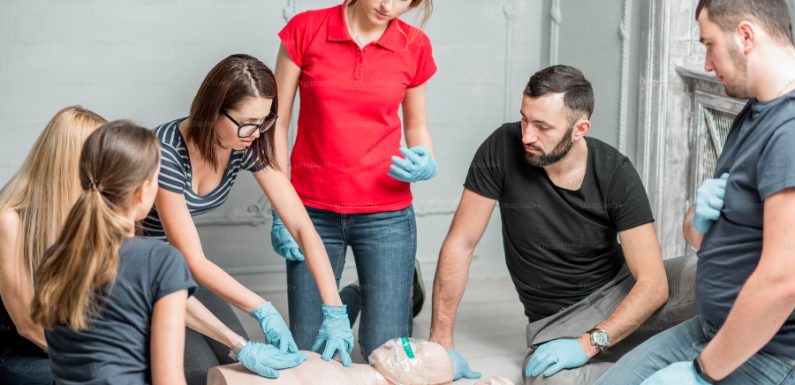
CPR stands for cardiopulmonary resuscitation. This procedure can be a lifesaver in emergency situations. This first aid technique can be used in situations like heart attacks or when someone’s heartbeat is faint or has stopped, cardiac arrest, blood loss, poisoning, anaphylaxis, and during a drug overdose. Remember, during a crisis, it is better to do something helpful than to stand and watch. Whatever little thing you do in such times can save another person’s life. Each and every adult should consider going for first aid training in particular CPR lessons because you never know when a disaster will strike.
How CPR works
Proper cardiopulmonary resuscitation is done with rhythmic chest compressions and mouth-to-mouth breathing. The procedure helps in pushing oxygen into the lungs of the affected person so that it reaches the brain and enables the individual to stay alive. A typical process involves thirty chest compressions accompanied by two deep breaths. However, this does not mean that you should stop administering first aid to the victim. Continue with other methods until the individual is stable then take him or her to the nearest hospital.
CPR is a simple technique that anyone with a keen interest can learn and perform. However, knowing how to do it properly is vital.
How to learn cardiopulmonary resuscitation
If you want to know how to effectively administer this life-saving technique to a person in need, it is advisable for you to take an accredited first-aid training course. There are three recognized methods of performing CPR which includes:
The standard method
The regular procedure for resuscitation involves compression to ventilation ratio of 30:2; 30 compressions to 2 mouth-to-mouth breaths in adults. For children, the ratio is 15:2. The pulse check should be conducted for not more than 10 seconds and should be done by trained health providers. In adults, the rescuer should use his or her palms for chest compressions. In children, it is advisable to use one hand and in infants, you should use two fingers; the index together with the middle finger.
Compression only method
Also known as a hands-only method, this technique involves chest compressions alone without artificial ventilation. This process is recommended for untrained rescuers and those without knowledge as far as CPR is concerned. It is easy to carry out and with the help of an experienced person; you can follow the instructions via a mobile phone. This method can be effective in adults suffering from minor cardiac arrest. However, it can give mixed results when it comes to children. Therefore, the standard procedure is applicable to kids at all times.
Reverse CPR
This procedure should be carried out on someone lying on his or her chest. You should turn the patient or victim’s head slightly to the side before the procedure begins. Doing this reduces the risk of vomiting as a result of aspiration pneumonia. This technique should be done by a trained professional and in situations where turning the patient to lie on his or her back is a problem. In pregnant women, CPR should be performed when the woman is lying on her side. If you make her lie on her back, you might cause complications to the uterus.
Why CPR?
Research shows that the human brain can survive for up to five minutes without oxygen before it is damaged completely. Therefore, this life-saving technique, if done appropriately, can enable someone to make a full recovery even after an accident. You might think that calming the victim down and calling for an ambulance is enough to save his or her life, by doing this you might increase the risk significantly. Hence, you should consider doing some first-aid procedures as you wait for medical help or an ambulance.
What are some of the benefits of learning CPR?
Lifesaving
This training allows you to save lives. With a certification, you can be called upon to help in rescue missions in case of disasters. Cardiac arrest and heart attacks are known to be the leading causes of death in the world today. And having knowledge on how to perform cardiopulmonary resuscitation would help prevent these deaths.
Empowering
This training gives you the ability to help out someone in need. For example, if your child suffers from a cardiac arrest, and you have no idea what is ailing him or her, the child might die. But if you have this essential skill you can quickly save the kid’s life because you know what is expected of you and how to do it.
Working
Certain jobs require CPR certification. In some situations having a certificate will improve your chances of getting a good job. For example, when applying for jobs like a personal trainer, a babysitter, lifeguard or a kindergarten teacher, it is a requirement.
It gives you courage and confidence
Knowing that you can save another person’s life will give you the courage to face the challenges of life head-on. You will be confident in life, at work and have better relationships with people around you.
In summary, the world today requires individuals who are ready for anything. The best way to ensure that you are ready for any eventualities is by taking CPR courses. For more information on how to retain heart health, read more here.
Sponsored by villasantonioapts.com

